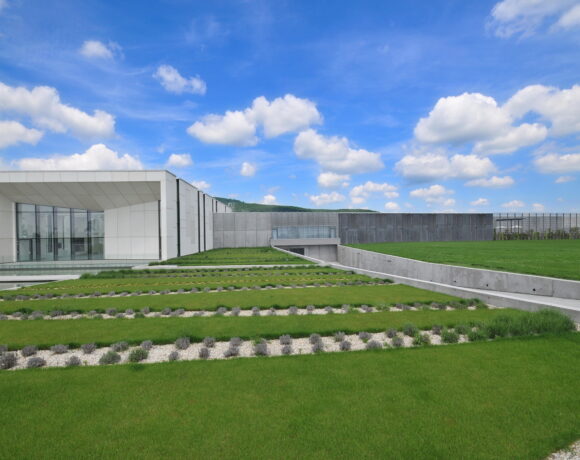Founded in 1984 by Alain Dominique Perrin, at that time President of Cartier International, thanks to the suggestion of the artist César, the Fondation Cartier, for the European continent, is one of the first examples of corporate patronage aimed at contemporary culture. Ten years later the Foundation left the space of Jouy-en-Josas to take up residence in Paris in a building (made of glass and steel) designed from scratch by the great architect Jean Nouvel who, with a simple and beautiful architecture, anticipated certain salient aspects of the vertical forest by Boeri, reconverting the simple garden with spontaneous herbs.
As proof of its profitable activity and its worldwide attention, the collection of the Foundation is approaching 2 thousand works. Furthermore, as proof of an uninterrupted work of relationships and intertwining at multiple levels, the Foundation has signed an eight-year collaboration agreement with Triennale di Milano, a pact of which we can see a testimony in the exhibition signed by Guillermo Kuitca, “Les Citoyens” with twenty-eight artists from seventeen countries and which will remain open until 12 September.
Now, from 6 July (and until 2 January next year), in Paris, the Foundation is hosting “Cherry Blossoms” by Damien Hirst.
On this cycle of works (a total of 107 large canvases, although only about thirty will be exhibited here, selected by Hervé Chandès, director of the Foundation, together with Hirst) here is the author’s testimony:
“The Cherry Blossoms are about beauty and life and death. They’re extreme – there’s something almost tacky about them. Like Jackson Pollock twisted by love. They’re decorative but taken from nature. They’re about desire and how we process the things around us and what we turn them into, but also about the insane visual transience of beauty – a tree in full crazy blossom against a clear sky. It’s been so good to make them, to be completely lost in color and in paint in my studio. They’re garish and messy and fragile and about me moving away from Minimalism and the idea of an imaginary mechanical painter and that’s so exciting for me “.
The subject of this cycle, concluded last year in November, may seem trivial, but if we remember the episode of Kurosawa’s cherry blossom in the film “Dreams” we can understand how poetry can arise from the most insignificant detail and for Hirst, accustomed to upsetting our most superficial expectations, even this minimal subject, this detail of nature (which for many people will seem insignificant) is in the end only a pretext to tell about his painting, his way of being in the world and the temporal scan that guides our actions. In fact, these are trees taken from his garden in Devon, so with good reason we can also speak of Neo-Impressionism, without in any way wishing to diminish the scope of his work. And that David Hockney also dwelt on the cherry trees is not just a fortuitous coincidence, since both authors are originally from Yorkshire. It must also be said that the petals are not really represented in a realistic way but respond to a dot that tastes so much like coriander stuck to the pictorial surface, and it is precisely this visual trick that makes the banality of the subject great, as Warhol’s out-of-register frames made the irregularity of the pictorial drafting is sublime. The pigment of this cycle is in any case pasty, dense, vibrant and also involving; certainly light years away from his works of the nineties, such as the tiger shark in formaldehyde (“The Physical Impossibility Of Death In the Mind Of Someone Living” 1991) or the cow and calf cut in two (“Mother and Child, Divided” 1993). But we must agree: exuberance cannot have limits and Hirst is a truly exuberant artist.
Fabio Fabris
Info:
Damien Hirst. Cherry Blossoms
6/07/2021 – 2/01/2022
Fondation Cartier pour l’art contemporain
261, Boulevard Raspail
75014 Paris, France
tel +33 1 42 18 56 50
info.reservation@fondation.cartier.com
 View from Damien Hirst’s studio. Photograph by Prudence Cuming Associates. © Damien Hirst and Science Ltd. All rights reserved, DACS 2021. Ph courtesy Fondation Cartier pour l’art contemporain in occasione della mostra “Cherry Blossoms”
View from Damien Hirst’s studio. Photograph by Prudence Cuming Associates. © Damien Hirst and Science Ltd. All rights reserved, DACS 2021. Ph courtesy Fondation Cartier pour l’art contemporain in occasione della mostra “Cherry Blossoms”
 Damien Hirst, The Triumph of Death Blossom, 2019. Photographed by Prudence Cuming Associates. © Damien Hirst and Science Ltd. All rights reserved, DACS 2021. Ph courtesy Fondation Cartier pour l’art contemporain in occasione della mostra “Cherry Blossoms”
Damien Hirst, The Triumph of Death Blossom, 2019. Photographed by Prudence Cuming Associates. © Damien Hirst and Science Ltd. All rights reserved, DACS 2021. Ph courtesy Fondation Cartier pour l’art contemporain in occasione della mostra “Cherry Blossoms”
 Artavazd Pelechian, Les Habitants, 1970, 35 mm black-and-white film, 8 min 58 s. Acquisition 2015. © Artavazd Pelechian. Ph courtesy Fondation Cartier pour l’art contemporain in occasione della mostra “Les Citoyens”
Artavazd Pelechian, Les Habitants, 1970, 35 mm black-and-white film, 8 min 58 s. Acquisition 2015. © Artavazd Pelechian. Ph courtesy Fondation Cartier pour l’art contemporain in occasione della mostra “Les Citoyens”
 Tony Oursler, Mirror Maze (Dead Eyes Live), 2003, projected videos on 10 spheres (diameter 1.8 c each), soundtrack, dimensions variable. Commission for the exhibition “Yanomami, Spirit of the Forest” 2003. Acquisition 2003. © Tony Oursler, photo © Hironori Itabashi. Ph courtesy Fondation Cartier pour l’art contemporain in occasione della mostra “Les Citoyens”
Tony Oursler, Mirror Maze (Dead Eyes Live), 2003, projected videos on 10 spheres (diameter 1.8 c each), soundtrack, dimensions variable. Commission for the exhibition “Yanomami, Spirit of the Forest” 2003. Acquisition 2003. © Tony Oursler, photo © Hironori Itabashi. Ph courtesy Fondation Cartier pour l’art contemporain in occasione della mostra “Les Citoyens”

is a contemporary art magazine since 1980






NO COMMENT